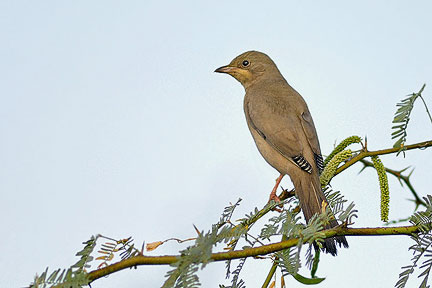
Kachchh(Kutch) mein gadein madey alag jhat jha pakshi aein . Maliney 370 jhat jha pakshi kachch mein malentah.
Kachchh birdlife is particularly rich in raptors, waterfowl, waders and larks. Specialties include the Grey Hypocolius (Kutch is the only known wintering site in India), White-naped Tit, Stoliczka’s Bushchat, Sykes’s Nightjar, Greater Hoopoe Lark, Merlin, McQueen’s and Indian Bustards. Over 30,000 Common Cranes, hundreds of Steppe Eagle, Marsh, Pallid and Montague’s Harriers, Long-legged Buzzards, Sandgrouse, Pelicans, Flamingos and great flocks of Greater Short-toed Larks are a feature of any winter visit to the area.
The Little Rann of Kutch is a bird watcher’s paradise in winter. Houbara bastard, sandgrouse, desert chat, desert wheat ear, nine species of larks, quails, gray francolin etc are seen in the saline desert wilderness. Eagles, vultures, harriers and falcons can be seen hunting in the Rann. The marshes in the Rann, and nearby lakes like Nawa Talao and Vanod Saran, attract huge flocks of water birds. Flamingoes, pelicans, cranes, storks, ducks etc can be seen in large numbers.More than 200 bird species live in these seasonal salt marshes. Three of these species are threatened: the lesser florican, Houbara bustard, and Dalmatian pelican. During the wet season, the marshes become pink with flamingos. This area is the home of the largest flamingo breeding colony in the world. Millions of these tall, pink birds fly here each year to nest and raise their young.
The Little Rann of Kutch is a birding paradise and has been declared a Ramsar Site. Birds here include Steppe, Imperial, and Short-toed Eagle, Houbara Bustard, flamingos, pelicans, storks and cranes. The best birding is during the winter months from October to March when waterfowl gather in vast numbers. These are the months when Demoiselle and Common Crane, and Lesser Flamingo are seen in incredibly large numbers.During the rainy season, you see a rich array of wildlife especially the pink flamingos which flock to acres of salt marsh flowering plants. Flamingos build clay nests that rise above the water. There, both parents tend the eggs. Flamingos feed while standing in shallow water. They lower their necks and tilt their heads so that their bills hang upside-down and face backward in the water. In this way they filter plankton, red and blue-green algae, insects, fish, mollusks, and small crustaceans from the water. This diet, mostly the red and blue-green algae and insects which are high in alpha and beta carotenoid pigments, is what causes the flamingos striking pink color.
Three-fourths of this eco-region is protected. Cattle grazing, cutting trees for fuel and commercial mining of salt all pose threats to the eco-region even those areas that are protected. People also drive across the mudflats, and their vehicles damage the fragile ecosystem.



 01:00 AM
01:00 AM
 nikhil
nikhil

0 ટિપ્પણી(ઓ):
ટિપ્પણી પોસ્ટ કરો